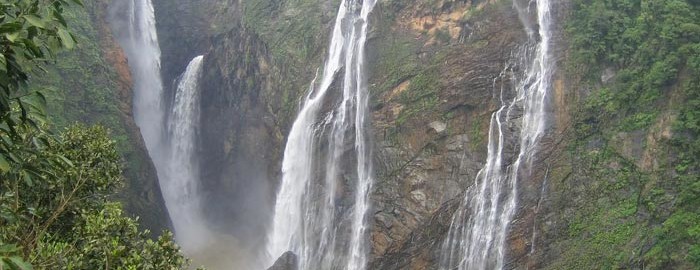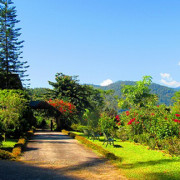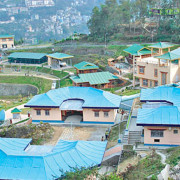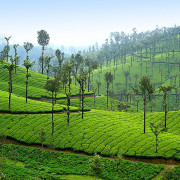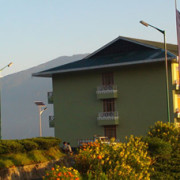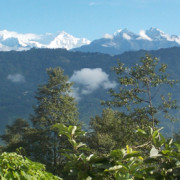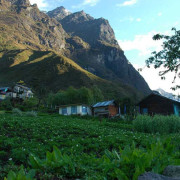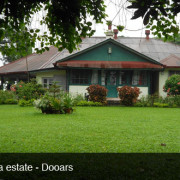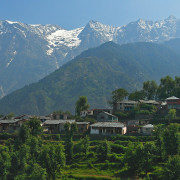Panchmarhi, Madhya Pradesh – The Queen of Satpura Ranges
Panchmari is the only hill station in Madhya Pradesh. Its excellent climatic attracts the tourist all the year round. The Satpura forest emboldens this sight. It was a favourite place of the Sahibs. It is a verdant gem. The place offers excellent tranquility and is an ideal destination for spending a holiday absolutely idle enjoying the beauty of nature. Complementing the magnificence of nature are the works of man; Pachmarhi is also an archaeological treasure- house. In cave shelters in the Mahadeo Hills is an astonishing richness in rock paintings. Most of these have been placed in the period 500-800 AD, but the earliest paintings are an estimated 10,000 years old. Pachmarhi is ideal for unwinding, effortlessly. Roads meander gently. The groves of trees, open spaces and heritage cottages sit peacefully in their old gardens. It seems as if the town has a quiet gentility about it as if Victorian traditions and high collars still governed most people’s lives. Much of this ambience has been set, and is still being maintained, by the strong presence of the Army whose Education Corps is head-quartered here. The old cottages are maintained by the Military Engineering Services, have changed little since the days of Kipling.
Places to see at Panchmari: Panchmari offers quite a lot of attractions.
Priya Darshini (Forsyth Point)
This view point marks a clear view of the place from where Pachmarhi was discovered by Captain Forsyth in 1857. The British developed Pachmarhi as a resort and their influence is embodied in its churches and colonial architecture.
Jamuna Prapat (Bee Fall)
It is a spectacular fall in the stream that provides drinking water to Pachmarhi. The bathing pools above the fall are very popular. Handi Khoh: Pachmarhi’s most impressive ravine has a 300 feet high precipice and dramatically steep sides.
Apsara Vihar (Fairy Pool)
Easily accessible from Jai Stambh, this ‘fairy pool’ is an ideal picnic spot for families with small children, since the pool is shallow, deepening only towards the base of the fall.
Rajat Prapat (Big Fall)
Those seeking adventure will find it in this ten-minute walk over rocks and boulders from Apsara Vihar to the top of Rajat Prapat, the ‘big fall’. IRENE POOL This pool was discovered by Irene Bose, wife of Justice Vivian Bose, and named after her. The route upstream leads to a cave, through which the stream goes underground and then over a khud in a series of falls.
Jalawataran (Duchess Falls)
The descent is steep and the trek strenuous for almost all of the 4 km to the base of the fall’s first cascade.
Sunder Kund (Saunder’s Pool)
Crossing the stream below Duchess Fall and following a footpath about 2.5 km in a south- west direction, brings one to a huge rocky pool that is excellent for a refreshing swim.
Mahadeo
Mahadeo hill, that is regarded as holy for countless of generations, has a shrine with an idol of Lord Shiva and an impressive Shivlinga. On the East side of the hill is an excellent cave shelter with beautiful cave paintings.
Chhota Mahadeo
Revered as a sacred spot, this is a narrow point in the valley with rocks overhanging a stream and a spring from where water cascades down.
Chauragarh
4 km from Mahadeo, it is one of Satpura’s prominent land marks, the summit crowned with emblems of Mahadeo worship.
Jata Shankar
It is a sacred cave under a mass of loose boulders in which the Jambu Dwip stream has its source. A rocky formation of this place resembles the matted locks of Lord Shiva, hence the name.
Dhoop Garh
This is the highest point in the Satpura range, with a magnificent view of the surrounding ranges. A very popular spot for viewing sunsets.
Pandav Caves
The five ancient dwellings excavated in the sandstone rock in a low hill, Pachmarhi derives its name from these caves which, as the legend goes, once provided sanctuary to the five Pandav brothers. These caves are now protected monuments.
Tridhara (Piccadily Circus)
A popular picnic spot where two streams meet in a junction.
Vanshree Vihar (Pansy Pool)
A beautiful spot on the Denwa stream, cool and shady among trees, ferns and semi-tropical vegetation.
Reechh Garh
A wonderful natural amphi-theater in the rock, approached through a cave-like entrance on the South-side.
Sangam (Fuller’s Khud – Waters Meet)
This is the lowest of the picnic spots on the Denwa and offers fairly good bathing pools both below and above the meeting of the waters.
Catholic Church
Built in 1892 by the British, the Catholic Church is a blend of the French and Irish architecture. Its Belgium stained-glass windows add rare attraction and beauty to the building. The church has a cemetery attached to it and graves date from 1859, World War I & II.
Christ Church
This Church built in 1875 by the British has a fascinating architecture its ‘sanctum- sanctorum’ has a hemispherical dome on top with its ribs ending with faces of angels. The stained glass panes adorning the walls and rear of the altar were imported from Europe. They present a gorgeous view as the sun rays pass through them. The nave of the church does not contain even a single pillar for support. The baptismal font is a rare brass piece and the bell is as old as the church and its chimes can be heard from a long distance.
Satpura National Park
Set up in 1981, Satpura National Park is 524 sq km in area. It spreads through dense forest of evergreen sal, teak and bamboo. The high peaks of Dhoopgarh and Mahadeo, Bori’s legendary teak and bamboo forests, Pachmarhi’s fascinating natural beauty of deep valleys, high mountains, rivulets, waterfalls and Tawa’s vast reservoir combine to give this park unique beauty and a breathtaking variety of attractions. The park is home to the bison, tiger, Leopard, bear, four-horned deer, blue-bull and a rich variety of birds.
Bison Lodge
The Bison Lodge built in 1862, is the oldest house in Pachmarhi. It now houses a beautiful museum depicting the rich flora and fauna of Pachmarhi.
The Cave Shelters
Some of the best cave shelters and groups of shelters around Pachmarhi are, Dhuandhar, approached from the footpath to Apsara Vihar, the paintings mostly in white include a group of archers with the typical Gond bun and hooped earrings. Bharat Neer (Dorothy Deep), has well executed animal paintings and when excavated in the 1930s yielded many pottery shards and microliths. Asthachal (Monte Rosa), there are four shelters with paintings, comparatively early linear drawings. Along the northern side of Jambu Dwip valley are some six shelters with many paintings of animals and human figures, including a detailed battle scene. Harper’s Cave, so named because of one of its paintings – a man seated and playing a harp is close to the Jata Shankar Shrine. The Chieftain’s Cave derives its name from a battle scene showing two chieftains on horses. A terrace that runs the length of the South, South East and East faces of Kites Crag has some fine cave paintings, the majority of which are in white or outlined in red.
Echo Point
Here the people can experience the presence of the voice in the nature and can feel the moving spirit in nature.
Ramya Kund
The entry to Ramya Kund is from the small passage of reach garh. The water continuously comes out from the Ramya Kund. It is on the way when you go from Reachgarh to Chauragarh.
Handi Khoh
It is 300 feet deep ravine in V-shape created by two gigantic hills. It is said that the British officer Handi has committed suicide by Jumping into the ravine.
Patalkot
This is a valley inhabited by tribals surrounded by rich flora.
Nearby attractions from Panchmarhi: Located 78 km from Pachmarhi, Tamia is a picturesque site in the Satpura ranges and offers one of the most spectacular spots of the area., it is a sought after place by adventure seekers and nature lovers with its wide botanical diversity.
Things to do at Panchmari: Enjoy the sight scenes and breathe in fresh air in the lap of nature. If you are doing nothing just savour the lush scenic environment of Panchmarhi.
Best time to visit Panchmarhi: The best time to visit Pachmarhi is October to March for the pleasant and enjoyable weather as well.
How to go ?
By Air
Nearest airport is at Bhopal (195 km) connected by regular flights with Delhi, Gwalior, Jabalpur, Indore, Kolkata and Mumbai.
By Bus
Pachmarhi is connected by regular bus services with Bhopal, Hoshangabad, Nagpur, Pipariya and Chhindwara. Taxis are available at Pipariya.
By Rail
Pipariya (47 km), on the Mumbai-Howrah mainline via Allahabad, is the most convenient railhead.
Where to stay ?
There are plenty of private and government hotels available in Panchmarhi. Few options are:
Satpura Retreat (MPSTDC): +91- 07578- 252097
Glen View (MPSTDC): + 91- 07578- 252533, 252445
Hilltop Bungalow (MPSTDC): +91-07578- 252846
Hotel Pachmarhi: +91-07578 – 252170 Website: www.pachmarhihotels.com
Hotel Utkarsh: +91- 09425433747, 9479651567, 9479651566, 07578-252162, 252016 Website: www.hotelutkarsh.com
Note : Phone numbers given above are according to the information available with us. If you find any contact number/s given above is/are incorrect or not in use, please let us know.
.
.

